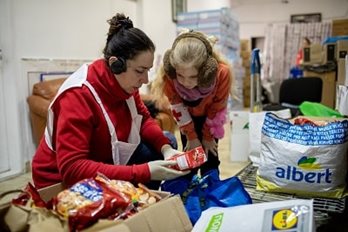 Russia is the largest exporter of wheat in the world, and Ukraine is the fifth largest. Together, they account for more than 30 per cent of the world’s cereal exports. It’s almost time to harvest, with crops typically being ready in June, but with millions of people having fled the violence it may not be possible for farmers and workers to access fields. Even if farmers were able to access them, fields may be unworkable.
Russia is the largest exporter of wheat in the world, and Ukraine is the fifth largest. Together, they account for more than 30 per cent of the world’s cereal exports. It’s almost time to harvest, with crops typically being ready in June, but with millions of people having fled the violence it may not be possible for farmers and workers to access fields. Even if farmers were able to access them, fields may be unworkable.There are countries that rely on these cereal exports, such as Lebanon, Syria, Yemen, and countries in the Horn of Africa, that were already facing some of the highest levels of food insecurity in the world.
According to the World Food Programme’s Global Report on Food Crises, as many as 179 to 181.1 million people are forecast to be facing crises or higher levels of hunger in 2022 The effects of the conflict in Ukraine to these countries’ food supply could be catastrophic.
While the conflict in Ukraine has received continuous media coverage, this food insecurity crisis is what we call a silent disaster. Silent disasters refer to disasters and emergencies that simply do not receive much or any media coverage. Many times, a silent disaster is a small- or medium-sized natural disaster, slow-moving, or complicated with multiple disasters such as drought, the COVID-19 pandemic and conflict converging.
 The Canadian Red Cross is working with local Red Cross and Red Crescent Societies to respond to this crisis. In Ukraine, this includes work in rural areas to repair damaged irrigation infrastructure, veterinary care for livestock, and assistance in planning for the next planting season. While these steps will help with recovery and future harvests, there is an immediate need in the countries already facing food insecurity. That is why the Canadian Red Cross is also working to help provide food, financial aid, healthcare, and other much-needed aid in other countries being impacted by this conflict.
The Canadian Red Cross is working with local Red Cross and Red Crescent Societies to respond to this crisis. In Ukraine, this includes work in rural areas to repair damaged irrigation infrastructure, veterinary care for livestock, and assistance in planning for the next planting season. While these steps will help with recovery and future harvests, there is an immediate need in the countries already facing food insecurity. That is why the Canadian Red Cross is also working to help provide food, financial aid, healthcare, and other much-needed aid in other countries being impacted by this conflict.Not every disaster will be a top news story, but their impacts will be felt all the same. The Red Cross and Red Crescent will continue to work to bring help to those who need it.
If you’re interested in supporting the work of the Red Cross in silent crises, you can make a donation to the International Programs Fund.
Related stories:

